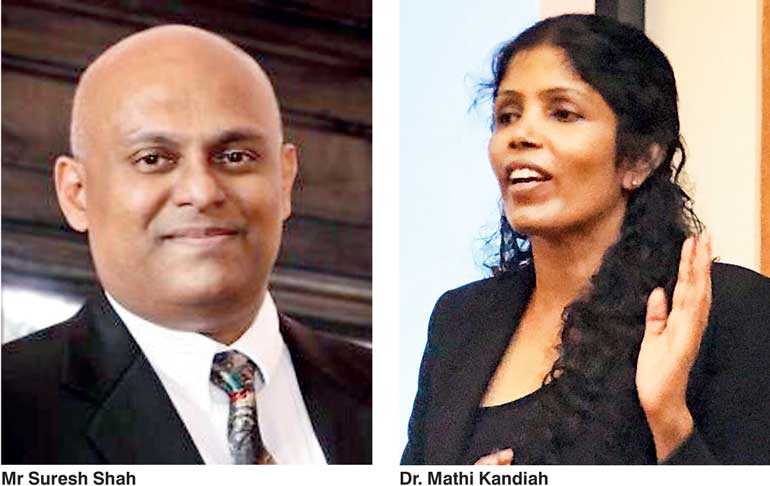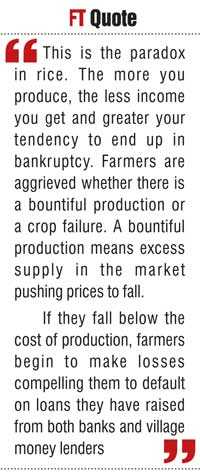Friday Jan 24, 2025
Friday Jan 24, 2025
Monday, 9 July 2018 00:10 - - {{hitsCtrl.values.hits}}

Eating too much of rice?
Sri Lankans are great rice eaters. On average, they eat 108 kg of rice per person per year as against the world average of just 54 kg per head. A plate of rice eaten by an average Sri Lankan is usually equated to Adam’s Peak or Samanala Kanda. The local saying is that if someone is to jump over it, it is so elevated in height that he has to make a lot of prior preparation and training. Otherwise, instead of jumping over it, he would just land in the middle of the plate.
This Sri Lankan practice of filling a plate with a heap of rice is followed even by Sri Lankan restaurants in other parts of the world.
For instance, the Sri Lankan food stall, Lanka Foods, at the Thailand based Asian Institute of Technology or AIT is a popular eating place not only for Sri Lankan students there but also for those from India and Bangladesh. The reason? Compared to the neighbouring Thai food stall which serves rice on the plate measured by a teacup, the Sri Lankan restaurant fills your plate with a Samanala Kanda. That Kanda can be eaten on average by three Thai students. This overfilling of the plate with rice amounts to its under-filling with meat and veggies, thereby going short of a balanced diet. Thus, Sri Lankans derive the entirety of their calorie requirement out of carbohydrate which, if not burned instantly, add to their waistline.

Wewai-Dagabai culture
Rice has been grown in Sri Lanka for thousands of years and the country’s inhabitants are proud of that long history. Hence, rice is not only their staple food but also a produce connoting great economic, political, cultural and spiritual significance.
In economic terms, they brand Sri Lanka as an agricultural land, mainly of paddy farming, that provides livelihood to a large number of people. Politically, it is so vital as a food item and if any government seeks to do even a small change in its production, distribution, marketing or consumption, that there are street agitations by people who are dressed in loin clothes, the main work-dress of a rural farmer many years ago.
Governments which tried to take away the famous rice subsidy from rice eaters have been voted out of power. Culturally, all folk rites, art and habits have been developed around the production of rice. Spiritually, the symbiotic combination of paddy farms and Buddhist icons, paraphrased in Sinhala as Wewai, Dagabai or Village Reservoir and Pagoda of the Buddhist Temple, have been identified as the door for reaching spiritual salvation by village folk.
Sticking to hard views is dangerous
These deep-rooted sentiments are being used by politicians, marketers and religious leaders to penetrate the farming community as an entry point and thereby win their support for their private enterprises.
Yet paddy farmers are poor and continue to be poor. This has become a crucial issue since Sri Lanka has now attained near self-sufficiency in rice and any increase in production levels means low market prices and low incomes for farmers.
At the same time, there is a wide gap between the price which farmers get, called the farm-gate price, and the price which consumers pay. This gap is usually about 20-25% of the farm-gate price. But farmers believe that it is as high as 100% and they are being exploited by all others in the value chain. The list is long but notable so-called exploiters are banks, millers, transporters, wholesalers and retailers. Therefore, anyone who promises to eliminate those exploiters from the chain can instantly win the hearts and minds of farmers. Politicians use it to the maximum.
Produce more and become bankrupt
This is the paradox in rice. The more you produce, the less income you get and greater your tendency to end up in bankruptcy. Farmers are aggrieved whether there is a bountiful production or a crop failure. A bountiful production means excess supply in the market pushing prices to fall.
If they fall below the cost of production, farmers begin to make losses compelling them to default on loans they have raised from both banks and village money lenders. Since the latter has harsh methods of recovery, farmers end up in losing their valuable assets. When it goes to an extreme point, farmers even choose to commit suicide. If there is a crop failure, again they lose income, despite the increase in the market prices. That is because they now do not have paddy to sell at those high prices. The decline in income due to crop failure causes the vicious circle outlined above to repeat itself. Thus, no matter whether the crop is good or bad, farmers are always poor. Politicians or religious leaders who always have a sympathetic eye for farmers do not seek to find the root cause of the problem and introduce a permanent solution.
Demand is flat despite increase in incomes
Though the income of Sri Lankans has increased phenomenally during the last 20 years or so, the quantity of rice consumed by them annually has remained flat at around 110 kg per person. Hence, rice as a food item has a fixed demand. Though increases in population are likely to increase the demand for rice, it normally does not happen since those who are elevated to high income levels have a tendency to eat less rice.
As a result, there is no way for the domestic market to absorb the excess if there is a glut in the market. In such a situation, the way out is to sell the excess to foreigners. But the short grain rice produced by Sri Lanka cannot be sold in foreign markets since their preference has been for varieties similar to Thai long grain rice. Thus, a glut leads to a reduction in domestic prices causing innumerable hardships to farmers, an instance of having poverty amidst plenty.
Corrupt marketing boards
Developing countries have sought to resolve this issue by establishing state-owned marketing boards. These boards are used to buy the excess supply at a minimum guaranteed price when the market price is below it.
Sri Lanka too established a Paddy Marketing Board with this objective in mind in early 1970s. However, the experiences throughout the globe have been that these boards have served not the farmers but the officials managing them for they are a fertile ground for breeding corruption.
A report by Rodney Fink for the US Agency for International Development or USAID in 2002 has noted that the underpaid civil servants in these boards resolve themselves to adopt corrupt practices with impunity, making the conditions of farmers worse (available at: https://commdev.org/userfiles/Corruption%20and%20the%20Agricultural%20Sector.pdf ). Hence, establishing marketing boards or strengthening existing boards is not the solution to the ‘problem of poverty among plenty’ as experienced by farmers.

Eat less while improving yields
The permanent solution lies in improving the yields of rice farmers, on the one hand, and creating a demand for rice as an industrial input on the other. The former will help farmers to beat the rising costs of production. The latter will facilitate Sri Lanka to absorb a glut in the market, use it to produce industrial goods and export such goods since it cannot export its short grain rice as a food item. If there is no surplus of rice for industrial use, such surplus can still be generated if Sri Lankans learn to eat less rice and more meats and fats.
Even a reduction in average per head consumption by, say 20 kg, will generate a sufficient surplus of about 42 million kg of rice for this purpose. These are long-term strategies based on proper awareness, changes in relative prices of rice as against meat and inventions made through the development of science and technology base of the country. The science part is the handiwork of a new subject area called ‘biotechnology’ which has now been added to the curricula of some state universities and private higher learning institutions.
Rice: The water guzzler
The problem with rice compared to maize or corn is that it is a ‘water guzzler’. In farming, paddy fields are flooded by water and about a half of that is lost through seepage and percolation. It is the balance half which is used by the rice plant for its own purposes, known as evaporation and transpiration.
The researchers at the Manila-based International Rice Research Institute or IRRI have computed, after verifying a vast amount of data collected from field surveys conducted throughout the globe, the amount of water used by rice plant to produce 1 kg of rice.
The total flooding of the paddy fields from sowing to harvesting will use about 2,500 litres of water to produce 1 kg of rice. About a half of this is lost through seepage and percolation; accordingly, the real use of water by the rice plant to produce 1 kg of rice is about 1432 litres (available at: https://www.scribd.com/document/34622848/Rice-Today-Vol-8-No-1).
Imagine the price of rice if water costs Rs. 1 per litre. Fortunately for consumers, water is supplied to rice farmers almost free of charge either through rains or government-sponsored irrigation schemes. But the shortage of water due to droughts will affect both the production and productivity of rice farmers. This is a serious problem in many rice producing nations like China, India and Sri Lanka.
Developing drought resistant paddies
Scientists in IRRI and in leading universities are now engaged in developing water-efficient paddy cultivation methods. IRRI has come up with an ‘alternative wetting and drying’ method. In this method, a field is flooded for a few days and after that water is used up, kept dry for a few more days before it is flooded again. This method is to save about 30% of water normally used in paddy farming without affecting the rice yield.
Another method suggested is sprinkling water in the field, producing ‘aerobic rice’ just like watering a leafy vegetable field. This would save water up to 50% but there would be a reduction in the output by about 30% (available at: http://irri.org/blogs/bas-bouman-s-blog-global-rice-science-partnership/does-rice-really-use-too-much-water).
Hence, it is useful in cultivating paddy in relatively water-scarce regions. But scientists at the University of Western Australia or UWA have attempted developing a new rice variety which is drought resistant so that it could alleviate drought stress (available at: https://research-repository.uwa.edu.au/en/publications/advances-in-drought-resistance-of-rice). This is the best method of cultivating rice in arid places like the Hambantota or Mannar districts in Sri Lanka.
Improve farm practices
The productivity of Sri Lankan farmers can be improved significantly through a change in farm practices. Sri Lankan rice farmers have mostly picked the skill either from their elders or from peers; in most cases, they are guided by marketers of weedicides and pesticides. Hence, they lack the skills in scientific farm management. As a result, there is a tendency for overusing inputs like freely available water or purchased inputs like fertiliser or pesticides. Any entrepreneur who is not conscious of his costs is likely to end up as cost-maximisers and in bankruptcy. Then it boils down to making farmers aware of the proper way of cultivating paddy in order to maintain a higher yield level continuously.
Divulwewa experiment by Lion Breweries
Already an experiment in this regard has been done by Lion Breweries with some 3,500 farmer families in Divulwewa in the North Central Province. Its CEO, Suresh Shah, explains the experiment as follows: “We got the selected farmers to a classroom and educated them of the whole process of cultivating paddy properly. They were given knowledge of the correct preparation of land, correct seeding, correct planting, correct water, fertiliser and pest management and finally how to harvest, thresh and offer paddy to the market. This new system of management, which did not involve any high technology or capital investment, helped farmers to get on average about 160 bushels per acre. Their previous yield rate was just 85 bushels. There were farmers who even went up to 200 bushels per acre. They were able to maintain these average yield levels continuously for five years.”
Lion Breweries, which is taxed heavily at 70% by the government because it is considered a ‘sin industry’, had to give up its experiment. When it withdrew from the project, it was necessary to replicate it in other areas of paddy farming. Shah says his attempt at canvassing it with the top government authorities was unsuccessful.
Significant improvements in yields
The production of 85 bushels per acre per year amounts to some 4,383 kg per hectare per annum and that is Sri Lanka’s present average yield rate of paddy. If it is increased to 160 bushels, it would increase the yield rate to 8,200 kg per hectare per annum, reducing the cost of production of farmers by half.
This is exactly what the Government should do today, instead of seeking to address minor issues of rice farmers and introducing palliatives to a perennial problem in the country. Shah says that Lion Breweries is willing to share its experience with anyone who wants to replicate this new farm management technique with other farmers in the country. The advantages are numerous. It would raise incomes of farmers, help them beat rising production costs, facilitate the alternative use of land for forestry, etc. conserve water which is a scarce resource today and generate a rice surplus that can be used as an industrial raw material.
Rice as an industrial input
Rice is now used increasingly as an industrial raw material in other parts of the world. Rice straw which is now wasted or burned down in fields is a good raw material for paper manufacturing; it is estimated that every kilogram of rice also produces 1-1.5 kg of straw which is a high harvest. Paper manufacturing using rice straw pulp can be started as a cottage industry by imparting the needed technical knowhow to villagers.
Rice can be used as malt for producing wine, whiskey and beer. This will open a good export market for Sri Lanka rice which cannot be exported as a food due to its shortness of the grain. Rice bran can be converted to rice bran oil, an alternative edible oil. Rice milk, like soy milk, is a substitute milk for those who have lactose intolerance.
Proteins isolated from rice can be presented as supplementary protein capsules like the fish oil capsules available in the market today. Rice can also be used for producing perfumes, a natural variety that will have a good attraction.
Local varieties are rich with antioxidants
New research will add more to this list. For instance, a paper presented by Thivanka Fernando and Mathi Kandiah (available at: http://multidisciplinaryjournal.globalacademicresearchinstitute.com/images/health/Thivanka%20Rochana%20Fernando,%20%20Dr.%20Mathi%20Kandaih.pdf) at the International Conference on Health and Medicine in 2017 has found that five local rice varieties, namely Heenati, Suwandal, Rathu Nadu, Pachchaperumal and Kurulu Thuda have a greater concentration of antioxidants than popular varieties of imported rice.
Even among the local varieties, the raw rice has a much larger concentration of antioxidants than cooked rice. The conclusion of the two researchers has been that when cooked, antioxidants get diluted to water and wasted away.
This, therefore, provides an opportunity for a businessman to use raw local varieties, especially Nadu which is produced in plenty in Sri Lanka, as an industrial raw material to isolate antioxidants and supply the same as a supplement to consumers. It is therefore a blue ocean or an unchartered territory for rice in Sri Lanka. All we have to do is to incorporate it into national policy, direct research into it and get the private sector into commercial production eyeing the export market.
It is now time for politicians to stop shedding tears about the pathetic condition of rice farmers in Sri Lanka. If they go to the source, they can offer permanent solutions for their multiple problems.
(W.A. Wijewardena, a former Deputy Governor of the Central Bank of Sri Lanka, can be reached at [email protected])